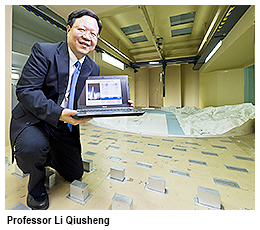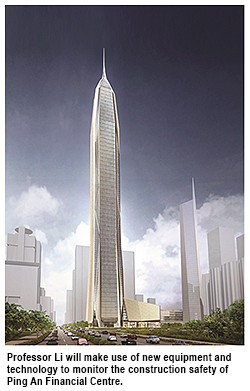CityU wins RMB7.2 million contract to monitor structural safety of Ping An Financial Centre
City University of Hong Kong (CityU) has been awarded a contract valued at RMB7.2 million (approximately HK$9 million) to monitor the construction safety and structural health condition of the Ping An Finance Centre, the tallest building in the Greater China Region. Professor Li Qiusheng from CityU’s Department of Civil and Architectural Engineering will use his innovative monitoring system to check the structural performance during its construction and monitor its structural safety after completion of construction.
Ping An Finance Centre, currently under construction in the commercial centre of Futian in Shenzhen, comprises a super tall office tower and a joint commercial building. At 118 stories above the ground and with five stories underground, the office tower has an overall height of 660 metres (588 metres for its main structure). Expected to be completed in 2015, it will be the tallest building in the Greater China Region and the second tallest in the world.
There are many factors, such as typhoons, rainstorms and humidity, which affect the design and the use of building materials for a super tall tower. They pose challenges to the construction process, too. The Integrated Monitoring System, developed by Professor Li and his research team, is capable of addressing these issues and won them the contract for “Construction Safety and Structural Health Monitoring for Ping An Finance Centre in Shenzhen”. Professor Li and his team will be responsible for checking the construction safety of the building structure and providing technical advice on the health condition of the building.
To achieve these objectives, Professor Li and his team will make use of the new monitoring equipment and technology that they invented with eight registered patents. They will also develop a new integrated system for monitoring the structural conditions of the building during and after construction. To provide accurate advice on construction and ensure the compliance of architectural design, the team is being installed around 500 sensors in the building. The sensors will collect on-the-spot meteorological data for wind speed, wind pressure and temperature as well as engineering data concerning deformation, stress and the vibration of the building and its components.
In addition, to ensure building safety after completion, Professor Li will use a software system developed by his team to evaluate the health condition of the entire building structure and its components based on the collected data of wind pressure and earthquake load as well as the response signals of the structure.
To achieve these objectives, Professor Li and his team will make use of the new monitoring equipment and technology that they invented with eight registered patents. They will also develop a new integrated system for monitoring the structural conditions of the building during and after construction. To provide accurate advice on construction and ensure the compliance of architectural design, the team is being installed around 500 sensors in the building. The sensors will collect on-the-spot meteorological data for wind speed, wind pressure and temperature as well as engineering data concerning deformation, stress and the vibration of the building and its components.
In addition, to ensure building safety after completion, Professor Li will use a software system developed by his team to evaluate the health condition of the entire building structure and its components based on the collected data of wind pressure and earthquake load as well as the response signals of the structure.
“Our integrated monitoring system can detect deviation and potential problems early during the construction process, which will ensure the precision of building a super tall structure. After the completion of construction, the sensors can continue to collect data for maintenance and repair to ensure safety,” Professor Li said. “Our success in winning the contract exemplifies the excellence of CityU’s research and its applications to actual engineering projects. Our technology can help build taller and safer super tall buildings in the future for the benefit of society.”
Professor Li has been studying wind engineering, structural dynamics, earthquake engineering, reliability and risk assessment over the years. He has published three books and 226 papers in international journals. His research project titled “Wind Effects on Super Tall Buildings: Field Monitoring, Wind Tunnel Testing and Numerical Simulation” won him the 2010 First Class Award of the Scientific and Technological Progress from the Ministry of Education of the People's Republic of China. He currently serves as the associate editor of the Journal of Structural Engineering of the American Society of Civil Engineers and an editorial board member for 10 international scientific journals.

